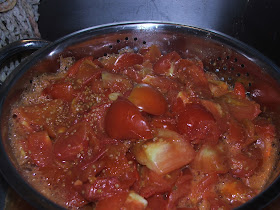We jammin' in the front yard
 |
| Here I am in front of the Columbia Star office building underneath the Pindo Palm, with what's left of a jar of Palm Fruit Jelly. |
From the front page August 31 edition of The Columbia Star
By Warren Hughes
Pam Staples remembers the long ago warmth of the country kitchen where she and the women of her family gathered for the annual ritual to preserve the summer fruits and vegetables.
The yearly practice in her grandmother’s mountain kitchen in western North Carolina was not only a culinary joy, it was also an economic habit that would ensure the large and extended family would have an abundance of vegetables, soups, and preserves from the gardens and orchards nearby to savor and sustain them in the long winter months to come.
The resilience and resourcefulness of her grandmother, Annie Jackson Smith, are a pivotal and lasting influence in Pam’s life. When she and her husband, Hugh, set up housekeeping in Ridgeway, those memories of what a home should be served as an inspiration. Ridgeway might not have the mountain views, but the nurturing nature of her grandmother’s gardening hand and the inspired flavor of her table offerings are the same.
“She was the best cook and homemaker I have ever known and the total pillar of the family,” Pam recalls. “She could always do absolutely everything from drying tears to milking cows, and everybody called on her for whatever the need was from a baby’s birth to a serious illness.”
Pam also reflects her grandmother’s genetic stamp of practical thrift and economic resourcefulness. When the economy took a downward turn, and food prices rose with the price of farm to market transport, Pam was undaunted and stepped up her pace with her natural frugality to keep the pantry full of delectable offerings that would last.
One evening, when Pam was about her tasks, her husband affectionately called her “Canning Granny” in deference to her grandmother’s influence and Pam’s own natural talent. Recognizing that his wife’s gift was special and her skill a dying art, he suggested she ought to start a computer blog to share her knowledge with others. “Hugh is my biggest supporter,” she fondly observes, and he no doubt is a most appreciative beneficiary of her efforts,
As her devoted fan, one could say a star was born that night. Following her husband’s advice, she shared on Facebook she was starting a blog on canning and preserving. Almost immediately, there was an enthusiastic cadre eagerly accessing her posts. The numbers quickly grew into the hundreds, and today there are some 17,000 from across the world including followers from Europe, South America, and Australia as well as in the United States.
While she reveres the values of the past, Pam, like most women, recognizes the necessity of staying on the cutting edge and possesses an impressive array of modern technology and computer skills. When she entered the job market in Columbia, she brought journalistic experience with her as a former employee of the Tryon, N.C, Bulletin, a talent quickly recognized by The Columbia Star publisher Mimi Maddock, who hired her as assistant editor.
Even with her daily professional responsibilities and newspaper deadlines, Pam, like her mountain forebears, always has her eye out for those environmental features she can appropriate for some practical and desirable use. The pindo palm tree at the entrance of The Columbia Star’s Shandon office did not escape her observant eye. Linda Sosbee, the financial manager, pointed out to the staff how sweet the plum-like fruit smelled. Pam’s mind immediately started spinning wondering how the fruit would taste and what she could do with it.
Her research revealed the fruit was non-poisonous and considered edible. If it could be done, Pam could do it. If marooned on an island as shipwrecked castaways, the survivors could only hope that someone with Pam’s resourcefulness would be among them. As Pam’s colleagues will attest, the jam that resulted from her experiment with the palm’s fruit is a sweet but tart prizewinner worthy of a blue ribbon at the State Fair.
Country biscuits brought to the office topped with the creation made for a great coffee break treat.
With school starting, her recipe for Sloppy Joes is enticing and with cold winter nights on the horizon. Her vegetable soup mix makes for some real comfort food just like granny used to make. Find her on Facebook, her blog at http://canninggranny. blogspot.com/ or pinterest at http://pinterest.com /source/canninggranny.blogspot.com/.
And if you'd like the recipe... here 'tis...
Palm Fruit Jelly
3 quarts ripe palm fruit
6 cups water
Simmer fruit in the water in a large saucepan until fruit is softened, about 30 minutes, crushing fruit with a potato masher as it cooks to release juices.
Strain fruit through several layers of cheesecloth, discard fruit, measure juice collected.
In a large stainless steel saucepan mix:
5-1/2 cups fruit juice
1 box powdered pectin (Sure Jel)
Bring mixture to a boil over high heat. When liquid reaches a full, rolling boil add all at once...
7-1/2 cups sugar
Bring back to a full, rolling boil and boil, stirring constantly, for one minute. Remove from heat and fill hot, sterilized half pint jelly jars to within 1/4 inch of the rim. Tighten hot, sterilized lids and rings on to fingertip tightness.
Process jars in a boiling water bath... ensure jars are completely covered with water, bring water to a boil, reduce heat to a gentle boil and boil, covered, for 10 minutes. After processing, remove jars from water using a jar lifter and set on a folded dish towel or cooling rack on the counter to cool and to seal.
For a printable copy of this recipe, click here.





















































